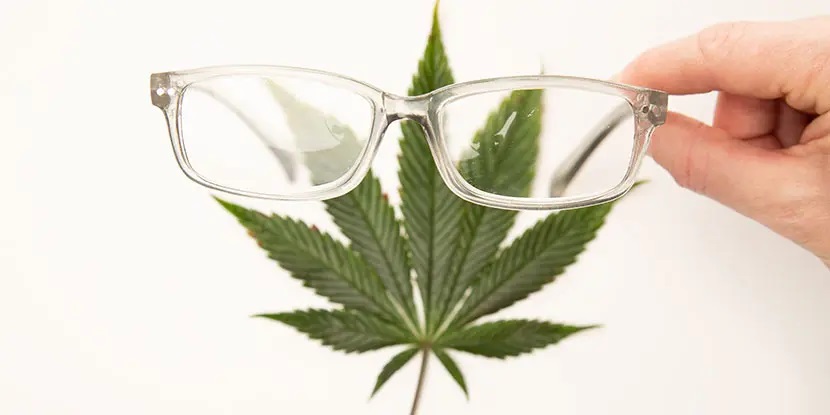
Glaucoma can be a very tricky thing to deal with. It is often hard to identify early on, and the damage has already been done by the time most people realize they have it. While there is no cure for glaucoma, treatments available can help slow the progression of the disease and prevent further damage. One of these treatments is marijuana.
Marijuana has been shown to be effective in reducing intraocular pressure (IOP), which is one of the main risk factors for developing glaucoma. Some people swear by its ability to relieve their symptoms and slow the progression of the disease, while others are staunchly against its use.
So, what’s the truth? Is marijuana a potential cure for glaucoma?
In this article, we will explore the potential of marijuana as a treatment for glaucoma and the risks and side effects associated with its use.
The Basics of Glaucoma
Glaucoma is an eye condition that occurs when the fluid pressure inside the eye becomes too high. This increased pressure can damage the optic nerve, which can lead to vision loss or even blindness.
Glaucoma typically occurs in older adults but can happen at any age. You’re at higher risk if you have a family member with glaucoma or African American, Hispanic, or Latino.
The two main types of glaucoma are open-angle glaucoma and angle-closure glaucoma.
Open-angle glaucoma is the most common type. It happens when your eye’s drainage system becomes clogged over time, causing the fluid pressure inside your eye to increase gradually.
Angle-closure glaucoma is less common but more serious because it can happen suddenly and without warning signs.
It occurs when your iris (the colored part of your eye) bulges forward, narrowing the angle between your iris and cornea (the clear front surface of your eye). This narrows or blocks fluid flow out of your eye, causing a sudden increase in fluid pressure inside your eye.
Getting regular comprehensive eye exams is the best way to detect glaucoma early and prevent vision loss. If you’re diagnosed with glaucoma, there are treatments available that can help slow or stop the progression of the disease.
Marijuana and Eye Pressure: The Research
Marijuana has been shown to be effective in reducing intraocular pressure (IOP), which is the main goal of glaucoma treatment.
A study conducted in 1971 and published in the Journal of the American Medical Association found that smoking marijuana reduced eye pressure in patients by an average of 30% if administered systemically for 3 to 4 hours.
The findings from this study prompted the National Eye Institute to fund research to determine whether marijuana or its active ingredient THC (tetrahydrocannabinol) could help keep IOP lowered in patients.
The research team concurred that when marijuana or THC is smoked, injected, inhaled through a vaporizer, eaten as a supplement, or used as tinctures can help to temporarily lower IOP.
However, they discovered that marijuana-based eye drops, rubs, and other external treatments are less efficient in lowering IOP.
While these findings suggest that medical marijuana could be a potentially effective option for some people, more research is needed to confirm the efficacy of marijuana as a treatment for glaucoma.
That’s because the current findings didn’t address all the aspects of how marijuana or THC can be used as a potential cure for glaucoma.
Other Potential Benefits
As a Preferred Alternative to Traditional Glaucoma Treatments
If left untreated, glaucoma can damage your optic nerve and lead to blindness. For that reason, anything that might help prevent or slow its progression is worth considering.
However, treating glaucoma may be difficult at times. Unlike marijuana, which can lower eye pressure for a few hours at best, traditional treatments have been shown to maintain consistent eye pressure.
But these treatments might be costly and have unwanted effects or allergic responses. So, some people with glaucoma may find marijuana to be a more affordable and tolerable option.
Also, those suffering from end-stage glaucoma may find marijuana a preferred alternative to reduce anxiety and depression.
Of course, since marijuana is not regulated by the Food and Drug Administration (FDA), it can be difficult to know what you’re getting. And there may be a lot of trial and error required before you find an effective glaucoma treatment.
That’s why it’s important to talk to your doctor before trying anything new, especially if you’re already taking medication for glaucoma.
Lower Cost
The cost of marijuana for glaucoma treatment is far less expensive than other glaucoma therapies that may cost hundreds or even thousands of dollars each month.
However, this may vary depending on the state or country in which you reside and the laws governing marijuana use.
In some cases, insurance companies may not cover the cost of synthetic medical marijuana drugs, such as Marinol. That’s because the FDA does not approve marijuana to treat glaucoma.
If you are considering using cannabis to treat your glaucoma, be sure to check with your insurance provider first to see what coverage may be available to you.
Downsides
Short-acting
The main downside to using marijuana as a treatment for glaucoma is that the effects are only temporary and must be constantly re-applied every three to four hours to maintain pressure relief.
That means you’d need to ingest roughly 18 to 20 mg of THC six to eight times a day, every day, in order to maintain a consistently reduced eye pressure.
This can become expensive and inconvenient because ingesting that much marijuana also comes with its own set of side effects, such as impaired motor function, paranoia, and anxiety.
Not FDA Approved
Another downside to using marijuana as a treatment for glaucoma is that it is not currently FDA-approved. This means that there is not a lot of scientific research to support its use as a treatment option.
Additionally, because it is not FDA-approved, insurance companies may not cover the costs of using marijuana to treat glaucoma.
Reduces Blood Flow
Since marijuana decreases blood pressure throughout the body, it stands to reason that it would also reduce blood flow.
This is especially true for the already compromised optic nerves, which are very sensitive to changes in blood pressure. As a result, marijuana use can lead to optic nerve damage and vision problems.
Mood-altering Effects
Marijuana’s mood-altering effect is caused by its active ingredient, THC.
When THC enters the bloodstream, it travels to the brain and binds to receptors there. This binding causes a change in the normal functioning of the brain cells and leads to the “high” that people feel when they use marijuana.
THC also alters other brain functions, including:
- how you process information
- your sense of time
- your coordination and movement
- your pleasure and sensory perceptions
- your ability to remember things
These changes can be short-term but can also have long-lasting effects, especially if you use marijuana frequently.
Toxin Exposure
Marijuana smokers are exposed to many of the same toxins as tobacco smokers, including carbon monoxide and tar.
Some research suggests that marijuana smokers have more difficulty breathing and suffer from more bronchitis than nonsmokers.
Smoked marijuana delivers THC and other cannabinoids to the body but also exposes users to harmful substances in the plant material.
Other Adverse Effects
Other potential adverse effects and side effects of using marijuana in glaucoma patients include:
- an abnormally increased heart rate (tachycardia)
- anxiety or paranoia
- impaired short-term memory
- coordination problems
- mood disorders, hallucinations, and delusions
- increased appetite
- headaches
- inability to concentrate
- inability to operate heavy machinery
- lung problems
- dry mouth
- dizziness
CBD Products for Glaucoma Treatment
Cannabidiol, or CBD, is a compound found in marijuana. Unlike THC, the compound that produces the “high” associated with marijuana use, CBD does not alter the mood. It is used for medicinal purposes.
There is no evidence that CBD products such as CBD oil and supplements can be used to treat glaucoma. In fact, according to the American Academy of Ophthalmology, CBD can actually raise eye pressure, worsening glaucoma.
Scientists are still exploring if the effect of CBD on lowering eye pressure is temporary or long-lasting.
Until more is known, the best advice for people with glaucoma considering trying CBD oil or other products for any reason is to talk to their eye doctor first. They can help you weigh the risks and benefits and determine if it’s right for you.
Other Treatment Options for Glaucoma
There are a few treatment options for glaucoma that you may want to discuss with your doctor. These include:
Medications
Several different medications can be used to treat glaucoma. The purpose of these medications is to decrease the amount of fluid produced in the eye or to help the fluid drain better.
The most common type of medication used to treat glaucoma is eye drops. These include beta-blockers, prostaglandin analogs, and carbonic anhydrase inhibitors.
Laser Surgery
This type of surgery is usually done in conjunction with other treatments, such as medications or conventional surgery.
Laser surgery is often used to treat angle-closure glaucoma, a type of glaucoma that occurs when the iris blocks the eye’s drainage angle.
Laser surgery can also be used to help improve the drainage of fluid in open-angle glaucoma. It can be done on an outpatient basis and usually takes only a few minutes.
Filtering Surgery
This type of surgery is more invasive than laser surgery and is typically reserved for people who have not responded well to other treatments. In this procedure, a new channel is created in order to allow fluid to drain from the eye.
As you can see, there are a few treatment options for glaucoma. It is important that you discuss all of your options with your doctor to determine which treatment is best for you.
Final Thoughts
While marijuana may be effective at reducing intraocular pressure, it hasn’t been shown to stop or reverse glaucoma’s progression. So while it may help you manage your symptoms, it’s not a cure for glaucoma. The studies conducted so far have been small, and more research needs to be done to confirm the efficacy of marijuana as a treatment for glaucoma. In the meantime, if you are living with glaucoma, there are other treatments available that can help lower your eye pressure and protect your vision. Talk to your doctor about what treatment options are right for you.
Frequently Asked Questions
Can glaucoma be cured?
Currently, there is no cure for glaucoma. However, treatment can help slow the disease’s progression and relieve symptoms.
Can marijuana really help cure glaucoma?
There is some evidence that marijuana can help relieve pressure in the eye, which is the main goal of treatment for glaucoma. However, there is no evidence that marijuana can actually cure glaucoma. More research is needed to confirm the effect of marijuana on glaucoma
How do I use marijuana to treat my glaucoma?
The most common way to use marijuana for medical purposes is to smoke it. However, other options are available, such as vaporizers, tinctures, and edibles if you don’t want to smoke.
How often do I need to use marijuana to treat my glaucoma?
You should use marijuana several times a day to treat your glaucoma. This may vary depending on the severity of your condition and how you respond to treatment.
What are the side effects of using marijuana to treat glaucoma?
Red eyes are the most common side effect of using marijuana to treat glaucoma. Other possible side effects include dry mouth, dizziness, and impaired coordination. These side effects are usually mild and go away after a few hours.





